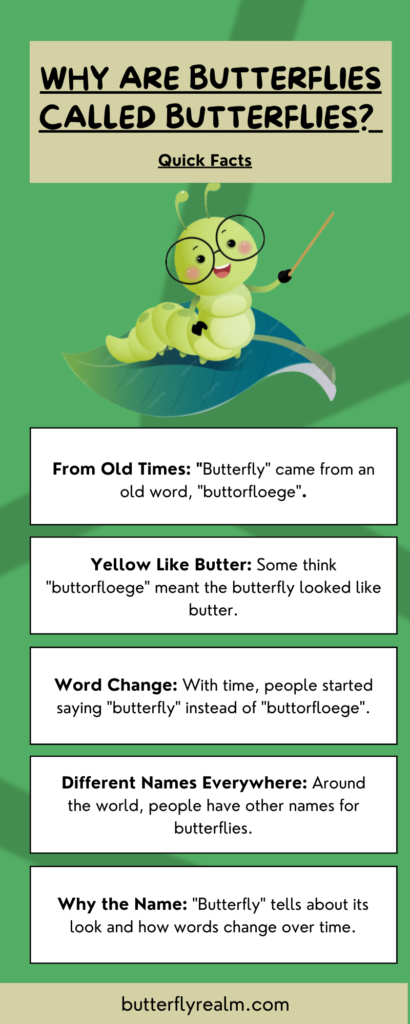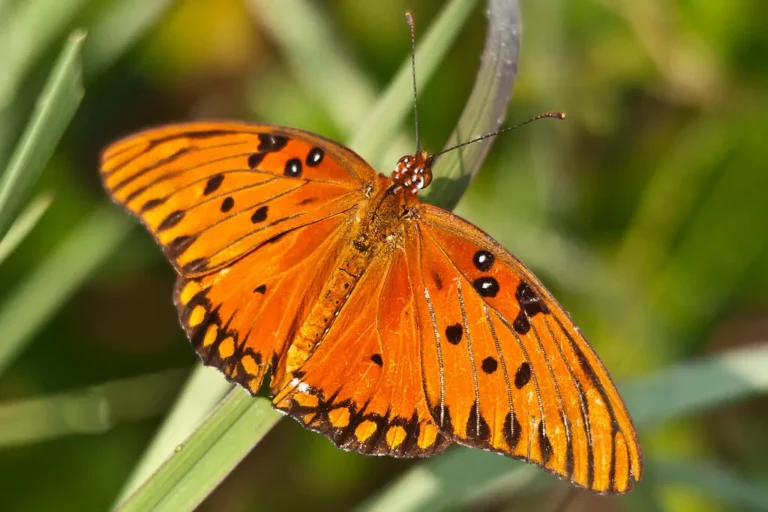Why Are Butterflies Called Butterflies? History & Origins
Butterflies are called ‘butterflies’ because of the Old English word ‘buttorfloege’, which might relate to the yellow color of some butterflies, like butter. Names for this insect vary across cultures, with each name having its own story. While many people use common names like ‘butterfly’, scientists use Latin names, such as ‘Lepidoptera’, to be exact. Names give clues about history, culture, and nature.

Table of Contents
Introduction
Butterflies are everywhere. We see them in gardens, parks, and even on some of our favorite things, like books and shirts. But have you ever stopped and thought, “Why Are Butterflies Called Butterflies?” It’s a fun name for such a colorful insect.
This question takes us on a journey through time. We’ll look at old languages like Old English and find out about the word “buttorfloege.” We’ll discover how “buttorfloege” became the word “butterfly” we use today. Along the way, we’ll learn about the language evolution and how the names of animals can change over time.
We’ll also explore what other cultures call butterflies and hear some interesting stories about them. Plus, we’ll find out if the way a butterfly looks or acts influences its name.
So, if you’re curious about the name “butterfly” and its story, keep reading!
Etymological Origins
The History of the Name
Names have stories, just like fairy tales. The story of “butterfly” takes us back many years. When we talk about the past, we often discover old languages and the interesting words they used. The history of “butterfly” is tied to language evolution.
Old English and “Buttorfloege”
Long before we started using the term “butterfly”, people in England had a unique name for this colorful insect: “buttorfloege.” It’s a term from Old English, which is like a grandparent to the English we speak today. If you try to say “buttorfloege,” you might notice it sounds a bit like “butterfly.”
How Names Change Over Time
Names can change for all sorts of reasons. Sometimes, it’s just because a new word sounds nicer or is easier to say. Other times, stories or popular beliefs shape the way names evolve.
For the butterfly, there are theories about its name’s connection to “butter.” Some people think it could be because certain butterflies are yellow, like butter. Others believe there might be old stories or myths that link the two together.
As people told stories, wrote books, and traveled around, the name “buttorfloege” slowly changed. And over time, this old name transformed into the modern word “butterfly” that we use and recognize today.
Cross-cultural Names and Perspectives
Names from Around the World
Just like in English, many languages have their own special names for the butterfly. These names can tell us a lot about how different cultures see and feel about butterflies.
The German “Schmetterling” and the French “Papillon”
In Germany, people call butterflies “Schmetterling.” It’s quite different from “butterfly,” isn’t it? And in France, they use the word “papillon.” Each name has its own story, just like “butterfly” in English.
Tales and Stories of Butterflies
Different cultures have their own tales and stories about butterflies. In some places, butterflies are symbols of hope or change. In others, they might represent beauty or freedom.
These stories can influence the names they choose for the butterfly. For example, the name might reflect the butterfly’s beauty or the way it flits around like it’s dancing.
What’s in a Name?
While “butterfly” might make us think of butter or flying, other names in different languages might have other meanings. It’s interesting to think about why different cultures picked the names they did. Is it because of the way the butterfly looks? The way it moves? Or maybe a special story or myth?
Understanding these cross-cultural names and perspectives can give us a richer view of the butterfly. It’s not just about the name, but also about the feelings, stories, and traditions linked to it.
Biological Perspective
The Life of a Butterfly
When you see a butterfly, it might be hard to imagine it ever looked any different. But before they become the colorful insects we love, they go through big changes. This journey, or life cycle, is one of the reasons butterflies are so interesting.
From Tiny Egg to Flying Beauty
It all starts with a tiny egg. From this egg, a caterpillar (or larva) hatches. This little caterpillar has one main job: eat! As it eats more and more, it grows bigger and sheds its skin a few times.
After a while, the caterpillar finds a safe spot and forms a chrysalis (or pupa). Inside this protective case, a big change happens. The caterpillar transforms! After some time, out comes a butterfly, ready to fly, and start the cycle all over again by laying eggs.
What’s in the Name?
You might wonder, does this life cycle have anything to do with the name “butterfly”? Well, some people think the name might be linked to how the butterfly looks or acts at different stages. For example, certain butterflies might look buttery-yellow when they fly, giving them their name.
Others feel that the smooth and flowing way they fly, almost like butter being spread, might have inspired the name.
The truth is, while we can guess and make connections, we’re not entirely sure if their biology influenced the name “butterfly.” But it’s fun to think about!
Butterflies in Literature and Art
A Timeless Symbol
Butterflies aren’t just found in gardens or parks. For a long time, they’ve also been in the stories we tell and the art we make. Why? Because they’re symbols of many things like change, beauty, and freedom.
Stories Old and New
From old folk tales to modern stories, butterflies often play special roles. Sometimes they’re magical creatures that help heroes on their quests. Other times, they’re symbols of hope and transformation. Think about it: a caterpillar changes into a butterfly, just like how characters in stories might grow or change.
Paintings and Pictures
Artists have always been inspired by nature, and butterflies are no exception. Whether it’s in detailed paintings or colorful children’s book illustrations, butterflies add a touch of beauty and wonder. Over time, some artworks featuring butterflies might have even influenced how we think about them or what we call them.
More than Just an Insect
When we see butterflies in literature and art, they’re often more than just insects. They’re symbols, characters, and even sources of inspiration. So, the next time you read a book or look at a painting, see if you can spot a butterfly and think about what it might mean in that story or artwork.
Evolution of the Name Over Time
Just like butterflies change as they grow, the name “butterfly” has its own story of change. Over time, words can shift in sound or meaning, and “butterfly” is no exception.
From “Buttorfloege” to “Butterfly”
We already learned about the Old English term “buttorfloege.” But how did we move from this old name to the one we use today? As people talked, wrote, and shared stories, the way they said the name slowly shifted. It’s a bit like a game of “telephone” where a message changes a little each time it’s passed on.
Influence of Stories and Culture
The way we see or think about butterflies can shape their name. If a popular story or poem talks about a butterfly in a special way, that can make people think of it differently. For instance, if a famous book described a butterfly as looking like flying butter, that idea could catch on.
Keeping Up with the Times
Language is always changing, and the names of animals are no exception. As we learned new things about butterflies or as they appeared in more books, movies, or songs, the name might shift or gain new meanings. It’s all part of the ever-changing world of language.
A Name with History
Today, when we say “butterfly,” we’re using a word with a rich history. It’s a blend of nature, culture, and language evolution. And it’s a reminder of how words, like the creatures they describe, can transform over time.
Other Insect Names: A Comparative View
The Wide World of Insects
Butterflies are just one kind of insect in a big family of many different bugs. Like butterflies, many of these insects have interesting names with their own stories.
Dragonflies: A Fiery Name
Take the dragonfly, for instance. With long wings and a slender body, it doesn’t really look like a dragon, right? Yet its name brings to mind images of fiery dragons soaring through the sky. Maybe it’s named for the way it swiftly flies or because of its ancient roots in stories and myths.
Ladybugs: A Lady’s Bug?
Another insect with a curious name is the ladybug. Why “lady”? Some say it’s because, in old stories, these little red bugs were considered lucky and were linked to the Virgin Mary, often referred to as “Our Lady” in some cultures.
The Naming Pattern
As we look at different insect names, a pattern starts to emerge. Many names seem to be linked to stories, myths, or things that people saw in nature. For example, the grasshopper might be named for its ability to hop in grassy fields.
Butterflies in the Mix
With its name rooted in old language and possibly old tales, the butterfly fits right into this pattern. It’s fascinating to see how each insect, from butterflies to beetles, has a name shaped by culture, nature, and language.
Phonological Analysis
Sounds and Words
Have you ever thought about the sounds in words? Every word we say has its own mix of sounds, and these sounds can sometimes give us clues about the word’s meaning or history.
The Sound of “Butterfly”
When we say “butterfly,” it has a gentle and flowing sound. The soft “b” and “f” sounds might remind us of the soft fluttering of a butterfly’s wings. The rhythm of the word, with two clear parts – “butter” and “fly,” could also hint at the idea of butter-like wings in flight.
Sound Connections
Words don’t just get their sounds randomly. Often, the way a word sounds can connect to what it means or how people feel about it. Think about words like “buzz” or “sizzle.” They sound a lot like what they describe, right? So, the way “butterfly” sounds might have some link to how the insect looks or moves.
Does Sound Shape Meaning?
It’s a fun idea to think about: did the butterfly get its name because of how the word sounds? Or did the sound of the word shape how we see the insect? It’s a bit of a mystery, but one thing is clear: sounds play a big role in our language and how we understand the world around us.
Sociolinguistic Factors
Language and Society
Words aren’t just sounds or letters. They are shaped by people, and in turn, they shape how people see the world. This connection between language and society is what sociolinguistics studies.
Different Names, Different Places
Even in places where people speak English, butterflies might have different names or nicknames. In some areas, they might be called something entirely different based on local traditions or stories. This shows how culture and community can shape language.
A Changing World, A Changing Name
As societies change, so do languages. If a community starts to see butterflies differently, maybe because of new stories or changes in the environment, the name or how it’s used might change too. This is why understanding how people and cultures view butterflies can give us clues about the name’s past and future.
Beyond Just “Butterfly”
In some cultures, specific types of butterflies might have special names. These names can tell us about what people in that place notice or value about those butterflies. For example, a butterfly that’s seen as a sign of good luck might get a name that means “lucky” or “blessed.”
The Social Life of a Word
Names aren’t set in stone. They live and change with people. By looking at the different names of butterflies around the world and how they’ve changed over time, we can learn a lot about people, cultures, and the connections between them.
Semiotic Analysis
Signs and Symbols
Everything around us can be a sign or symbol. A stop sign tells us to halt. A smile can show happiness. In the world of semiotics, which is the study of signs, we learn that things can have deeper meanings than we first think.
“Butterfly” as a Sign
When we say or hear “butterfly,” we don’t just think of the insect. We might think of beauty, change, or freedom. The word “butterfly” is a sign that brings many ideas and feelings to mind.
Beyond the Obvious
The real power of a sign is in its deeper meanings. For instance, butterflies often symbolize transformation because they start as caterpillars and change into flying insects. So, when someone talks about a “butterfly’s journey,” they might be talking about change and growth, not just the insect’s life.
Linking Ideas Together
In semiotics, the thing we see or hear (like the word “butterfly”) is called the “signifier.” The idea or feeling it gives us is the “signified.” Together, they make a complete sign. So, the “butterfly” (the signifier) can bring ideas of beauty, change, or nature (the signified) to our minds.
The Magic of Signs
This is what’s so special about language. Words are more than sounds or marks on a page. They’re keys to a world of ideas, stories, and feelings. And every time we use them, we’re taking part in the magic of signs and symbols.
Influence of Science and Taxonomy
What’s in a Scientific Name?
When scientists talk about plants, animals, or insects, they often use special names. These names are in Latin and help experts from all over the world understand each other. It’s like a shared language just for science.
The Butterfly’s Scientific Side
Butterflies belong to a big family with a fancy name: Lepidoptera. This word comes from Greek words that mean “scale” and “wing.” If you look closely at a butterfly’s wings, you’ll see they’re covered in tiny scales. So, their scientific name tells us something about them!
Common Names vs. Scientific Names
While many people might call a butterfly… well, a “butterfly,” scientists might use its Latin name. For example, the monarch butterfly is also known as “Danaus plexippus.” These Latin names give exact details about the butterfly’s kind and family.
Why Two Names?
You might wonder, “Why not just use one name?” Well, common names, like “butterfly,” are easy for everyone to use and remember. But they can be different in different places or languages. Scientific names are the same everywhere, so experts can be sure they’re talking about the same thing.
Science Shapes Understanding
As scientists study butterflies and give them Latin names, they also learn more about these insects. And the more we know, the better we can understand and care for them. Science and its way of naming things help us see the big picture of our world and all its amazing creatures.
Conclusion
The Journey of Understanding
From the gardens of our homes to the deep pages of history books, the butterfly has fluttered its way into many parts of our lives. As we’ve seen, its name carries stories, meanings, and mysteries from many corners of the world.
More Than Just a Name
“Butterfly” isn’t just a word. It’s a sign, a symbol, and a piece of history. It’s shaped by culture, society, and science. And in return, it shapes our feelings, our stories, and even our art.
The Power of Words
Our journey into the name “butterfly” shows us that words have power. They tell us about the past, the present, and sometimes even the future. And every time we use them, we add a little bit to their story.
Celebrating the Butterfly
So, the next time you see a butterfly, take a moment. Think about its name, its history, and its place in the world. And remember, like the butterfly, every word has its own special journey and story to tell.









